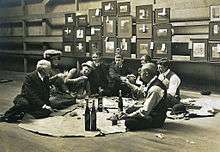David Henry Souter
David Henry Souter (30 March 1862 – 22 September 1935)[1] was an Australian artist and journalist. A stocky and humorous man, Souter wrote short stories, verse, light articles and plays, with a capable and ready pen. He did a fair amount of painting in watercolor, but his reputation rests on his black-and-white work, which, considering the mass of it, was very even in quality. He also illustrated volumes written by Ethel Turner and other Australian authors.
David Henry Souter | |
|---|---|
| Born | March 30, 1862 Aberdeen, Scotland |
| Died | September 22, 1935 (aged 73) |
| Citizenship | Australian |
| Occupation | Artist, Journalist |
| Spouse(s) | Jessie Swanson |
| Children | 2 sons, 3 daughters |
| Parent(s) | David Henry Souter and Ann Smith, née Gran |
Biography
Souter was born in Aberdeen, Scotland, the son of David Henry Souter, an engineer, and his wife Ann Smith, née Grant.[1] He did an apprenticeship under a house painter and sign maker when he was 12.[2] Souter studied art at the local branch of the South Kensington school, studying drawing,[2] contributed to a local journal from 1880, Bon Accord,[1] and went to Natal in 1881, where he engaged in journalism.
Souter married Jessie Swanson (died 1932) on 17 February 1886[1] and, together, they moved in 1886 to Melbourne, Australia, then settled in 1887 in Sydney. In Sydney, Souter obtained a position with John Sands and Company, where he worked as an illustrator for some time before moving to William Brooks & Co. Ltd. Souter contributed cartoons to The Tribune, and in 1888 founded the "Brush Club" for members under 26 years of age,[1] of which he became president. In 1892 he began contributing drawings to The Bulletin, and for a period of 35 years had at least one drawing in every issue. There are various stories about the cat which so frequently appeared in his drawings, one being that it was evolved from a blot that fell on a drawing at the last moment, and another that it first appeared to fill in a blank space. Some of Souter's cat studies are pictured in the children's nonsense rhyme book he wrote Bush Babs: with pictures (1933).[1] He relocated to South Africa in 1881.[2]

Souter left South Africa and moved to Sydney, Australia, in 1887.[2] When the Society of Artists was established at Sydney in 1895 Souter was elected to the council, and from 1901 to 1902 was its president.[1] He started drawing cartoons for the Tribune and News of the Week. In 1895 he became the lead cartoonist for The Bulletin, which he remained until he died.[2] Souter was art editor of Art and Architecture from 1904 to 1911, and for many years was associated with William Brooks and Company and illustrated many of the school books issued by them. In his later years he was on the editorial staff of Country Life.
Souter died suddenly at his home in Bondi, New South Wales on 22 September 1935, and was survived by two sons and three daughters.[1]
Publications
His separate publications were The Grey Kimono: the Libretto of an Operetta (1902).
Ten of Souter's watercolor paintings were shown at the exhibition of the Society of Artists, held at Melbourne in 1907. A scrapbook containing a collection of his earlier work from the Bulletin is in the public library, Melbourne. A collection of his World War I cartoons, reprinted from the Stock and Station Journal, was published at Sydney in 1915.
Gallery of works
.jpg) Mermaid with Companion, 1907
Mermaid with Companion, 1907.jpg) Souter's cover design for The Lone Hand magazine, 1909
Souter's cover design for The Lone Hand magazine, 1909 Poster by Souter for World War I recruitment campaign for nurses
Poster by Souter for World War I recruitment campaign for nurses.jpg) Sheep Amongst The Trees, 1931
Sheep Amongst The Trees, 1931.jpg) Jilted, 1933
Jilted, 1933
References
- Lindesay, Vane (1990). "Souter, David Henry (1862 - 1935)". Australian Dictionary of Biography. 12. Melbourne University Press. ISSN 1833-7538. Retrieved 12 February 2010 – via National Centre of Biography, Australian National University.
- "It is Nice in the Surf but What about the Men in the Trenches? Go and Help". World Digital Library. 1917. Retrieved 25 October 2013.
- Serle, Percival (1949). "Souter, David". Dictionary of Australian Biography. Sydney: Angus and Robertson.
External links
- Bush babs: with pictures / by D.H. Souter at the National Library of Australia